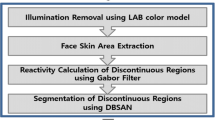Abstract
In this paper, we propose a novel method of cleaning up facial imperfections such as bumps and blemishes that may detract from a pleasing digital portrait. Contrasting with traditional methods which tend to blur facial details, our method fully retains fine scale skin textures (pores etc.) of the subject. Our key idea is to find a quantity, namely normalized local energy, to capture different characteristics of fine scale details and distractions, based on empirical mode decomposition, and then build a quantitative measurement of facial skin appearance which characterizes both imperfections and facial details in a unified framework. Finally, we use the quantitative measurement as a guide to enhance facial skin. We also introduce a few high-level, intuitive parameters for controlling the amount of enhancement. In addition, an adaptive local mean and neighborhood limited empirical mode decomposition algorithm is also developed to improve in two respects the performance of empirical mode decomposition. It can effectively avoid the gray spots effect commonly associated with traditional empirical mode decomposition when dealing with high-nonstationary images.
Similar content being viewed by others
References
Tomasi C, Manduchi R. Bilateral filtering for gray and color images. In Proc. the Sixth International Conference on Computer Vision, Bombay, India, Jan. 4–7, 1998, pp.839–846.
Weiss B. Fast median and bilateral filtering. ACM Trans. Graphics, 2006, 25(3): 519–526.
Buades A, Coll B, Morel J M. A non-local algorithm for image denoising. In Proc. IEEE Conference on Computer Vision and Pattern Recognition, San Diego, USA, June 20–25, 2005, Vol.2, pp.60–65.
Huang N E et al. The empirical mode decomposition and Hilbert spectrum for nonlinear and nonstationary time series analysis. In Proc. the Royal Society A: Mathematical, Physical and Engineering Sciences, March 8, 1998, Vol.454, pp.903–995.
Leyvand T, Cohen-Or D, Dror G, Lischinski D. Data-driven enhancement of facial attractiveness. ACM Trans. Graphics, 2008, 27(3): 38:1–38:9.
Nguyen M H, Lalonde J F, Efros A A, Fernando De la Torre. Image-based shaving. Computer Graphics Forum Journal, 2008, 27(2): 627–635.
Peers P, Tamura N, Matusik W, Debevec P. Post-production facial performance relighting using reflectance transfer. ACM Trans. Graphics, 2007, 26(3): 52:1–52:10.
Bitouk D, Kumar N, Dhillon S, Belhumeur P, Nayar S K. Face swapping: Automatically replacing faces in photographs. ACM Trans. Graphics, 2008, 27(3): 39:1–39:8.
Perez P, Gangnet M, Blake A. Poisson image editing. ACM Trans. Graphics, 2003, 22(3): 313–318.
Lin D, Tang X. Recognize high resolution faces: From macrocosm to microcosm. In Proc. IEEE Conference on Computer Vision and Pattern Recognition, New York, USA, June 17–22, 2006, pp.1355–1362.
Pierrard J S, Vetter T. Skin detail analysis for face recognition. In Proc. IEEE Conference on Computer Vision and Pattern Recognition, Minneapolis, USA, June 18–23, 2007, pp.1–8.
Matsui T, Arakawa K, Nomoto K. A nonlinear filter system for beautifying face images with enhancement using interactive evolutionary computing. In Proc. International Symposium on Intelligent Signal Processing and Communications, Yonago, Japan, Dec. 12–15, 2006, pp.534–537.
Kovesi P. Invariant measures of image features from phase information [Ph.D. Dissertation]. University of Western Australia, Australia, 1996.
Granlund G H, Knutsson H. Signal Processing for Computer Vision. Kluwer Academic Publishers, 1995.
Robbins B, Owens R. 2D feature detection via local energy. Image and Vision Computing, 1997, 15(5): 353–368.
Larkin K G. Uniform estimation of orientation using local and nonlocal 2-D energy operators. Optics Express, 2005, 13(20): 8097–8121.
Han C M, Guo H D, Wang C L. A novel method to reduce speckle in SAR images. International Journal of Remote Sensing, 2002, 23(23): 5095–5101.
Nunes J C, Guyot S, Del echelle E. Texture analysis based on local analysis of the bidimensional empirical mode decomposition. Machine Vision and Applications, 2005, 16(3): 177–188.
He L, Wang H. Spatial-variant image filtering based on bidimensional empirical mode decomposition. In Proc. International Conference on Pattern Recognition, Hong Kong, China, Aug. 20–24, 2006, Vol.2, pp.1196–1199.
Sinclair S, Pegram G S. Empirical mode decomposition in 2-D space and time: A tool for space-time rainfall analysis and nowcasting. Hydrology and Earth System Sciences Discussions, 2005, 2(1): 289–318.
Rilling G, Flandrin P, Goncalves P. On empirical mode decomposition and its algorithms. In IEEE-EURASIP Workshop on Nonlinear Signal and Image Processing, Grado, Italy, June 8–11, 2003.
Felsberg M, Sommer G. The monogenic scale-space: A unifying approach to phase-based image processing in scale-space. Journal of Mathematical Imaging and Vision, 2004, 21(1): 5–26.
Author information
Authors and Affiliations
Corresponding author
Additional information
This work is supported by the National Natural Science Foundation of China under Grant Nos. 60403038 and 60703084, the Natural Science Foundation of Jiangsu Province under Grant No. BK2007571, and the Natural Science Foundation of Liaoning Province under Grant No. 20082176.
Rights and permissions
About this article
Cite this article
Liu, YL., Xu, XG., Guo, YW. et al. Pores-Preserving Face Cleaning Based on Improved Empirical Mode Decomposition. J. Comput. Sci. Technol. 24, 557–567 (2009). https://doi.org/10.1007/s11390-009-9245-0
Received:
Revised:
Published:
Issue Date:
DOI: https://doi.org/10.1007/s11390-009-9245-0




